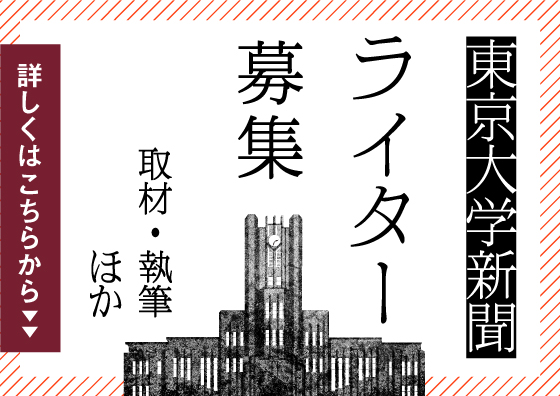We, without doubt, lay ourselves in “places,” which, if we heed the specialty of things therein orthe history therewith, appear to us as having a variety of meanings. In this serial article, we aimto contemplate various “places” found in Todai’s campuses with the cultural geographer Dr.James Thurgill, who interprets “places” by employing a knowledge of the humanities that spansphilosophy, history, anthropology, and so on. Our sixth meeting is at the Mathematics Building on Komaba Campus.
(Interviewed, Written and Translated by Mon Madomitsu)

Organicity Behind Inorganicity
The Mathematics Building (Photo 1), which stands at the edge of Komaba campus, is often referred to by students as the “Mathematics Hospital”. The bare concrete appearance of the building and the blunt look of the entrance hall (Photo 2) might perhaps contribute to giving us the impression of a hospital-like structure. Together with the stereotypical view of students majoring in mathematics as “unfashionable”, we might feel the building is somewhat unappealing. Yet, the truth is, those who call this building “hospital” do not look at the entire building so carefully as to see how it functions as a space. “Speaking from the perspective of cultural geography, I think this building is one of the most successful buildings on the Todai campus,” says Dr. Thurgill.
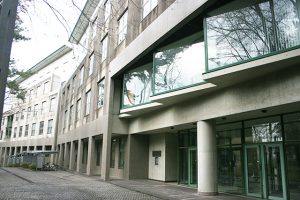
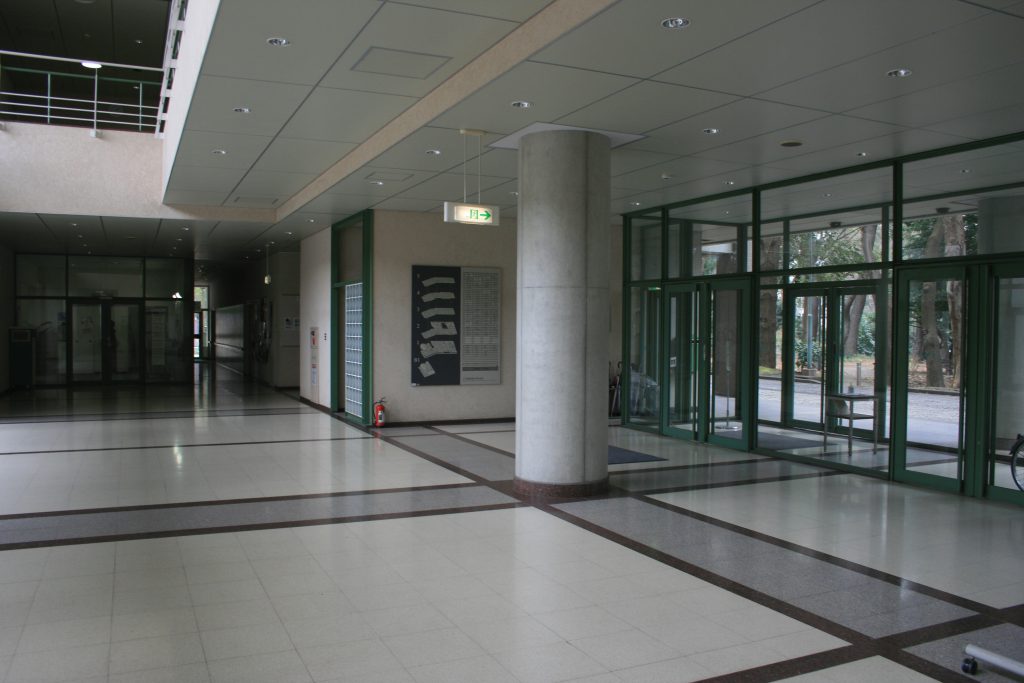
Some may wonder as to how a cultural geographer can speak properly about buildings. How successful buildings are in terms of their feeling or function as a structural form is, perhaps, a matter best left to the architects who design them. Dr. Thurgill states, however, that “thinking about how buildings fit into, affect and create spaces is also a geographical matter.”
Once we step into the Mathematics Building, we can immediately see that, beyond our expectation, it does not have a purely utilitarian structure, neither is it focused solely on the efficiency of people’s movement as a “hospital” might be. Constructed to fit into the sloped ground of this area, the building has a section where the border between the first floor and the basement level becomes ambiguous (Photo 3). Another interesting feature worth noting is the auditorium, which is itself an independent structure that has been built partially inside and partially outside the main building. As such, its labyrinth-like structure of corridors, gallery areas and mezzanine floors urges us to gain a multifaceted understanding of its space. Thus, there is a certain fluidity of the space found in the Mathematics Building that we might not initally expect to find. Additionally, the repetitive geometric shapes of triangles and squares that are spread throughout the interior of the building seem to portray the lively essence of mathematics itself, as opposed to our first impression of this building as something blunt and rigid.
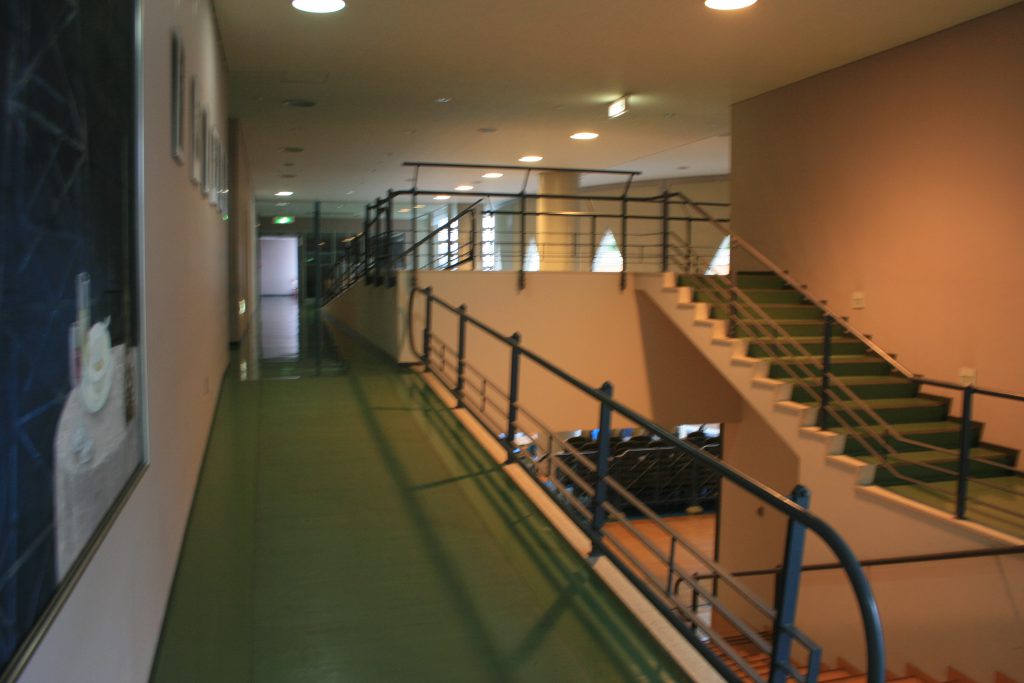
Now let us pay attention to the Yanaihara Park which unfolds in front of the Mathematics Building (Photo 4). “This building has a strong connection not only with mathematics but also with the surrounding area,” says Dr. Thurgill. Compared to the bright, glass-walled Komaba Library which stands beyond the park, the Mathematics Building has a less welcoming atmosphere. The circular-shaped Yanaihara Park that lies between these two structures, however, subtly binds the spaces together: the softening afforded by its “roundness” seems to harmonize the surrounding materials. In this way, the Mathematics Building maintains its connection to other places on Komaba campus.
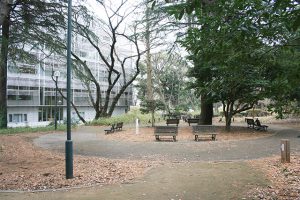
Dr. Thurgill points out, “The use of green and brown on the outside of the building, which at first looks somewhat inorganic, actually resonates with the colours of the trees and the sands in Yanaihara Park.” The building blends in and coexists with its surroundings as if it were a part of nature. Just as the architectural theorist Norberg-Schulz maintains that building deciphers a human understanding of nature into built form, the Mathematics Building, by integrating itself into its surroundings, works to reveal our understanding of nature.
From where, then, comes the idea that the Mathematics Building’s features appear inorganic and dull? At a first glance, the whole building looks like a flat wall, thus making us think of a border that marks the limit of the campus – this may have accentuated the impression that the building is located on the very edge of the campus where there is no sign of human activity. Yet, in the moment when we become mindful of the windows (Photo 5) above us that are set at a specific angle, and which invite the reflection of the sunlight upon them, the building that reflects the sky, which is itself borderless, is no longer just a wall; it turns itself into a being that transcends the border.
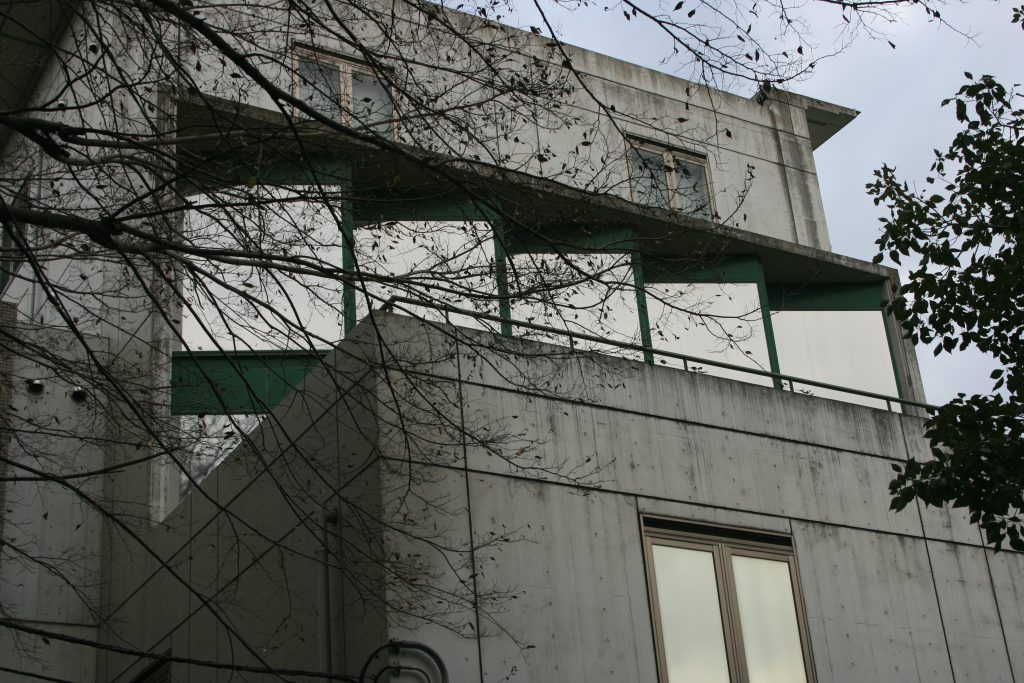
There will be a change to our initial impression of this building if we begin to think in such a way. For as we come to perceive the building as a part of nature, it ceases to be merely an inorganic block of concrete and instead becomes a place that we would like to explore.
【Japanese version】
【サーギル博士と歩く東大キャンパス⑥】 駒場Ⅰキャンパス 数理科学研究科棟
【関連記事】
Take a Walk through Todai’s Campuses with Dr. Thurgill #1 Akamon, Hongo Campus
Take a Walk through Todai’s Campuses with Dr. Thurgill #2 Sanshiro Pond, Hongo Campus
サーギル博士と歩く東大キャンパス③ 駒場Ⅰキャンパス 1号館
Take a Walk through Todai’s Campuses with Dr. Thurgill #3 Building 1, Komaba Campus
サーギル博士と歩く東大キャンパス④ 本郷キャンパス 総合図書館 【前編】
Take a Walk through Todai’s Campuses with Dr. Thurgill #4 General Library, Hongo Campus 【Part 1】
サーギル博士と歩く東大キャンパス④ 本郷キャンパス 総合図書館 【後編】
Take a Walk through Todai’s Campuses with Dr. Thurgill #4 General Library, Hongo Campus 【Part 2】
【サーギル博士と歩く東大キャンパス⑤】駒場Ⅰキャンパス 駒場池【前編】
Take a Walk through Todai’s Campuses with Dr. Thurgill #5 Komaba Pond, Komaba Campus 【Part 1】
サーギル博士と歩く東大キャンパス⑤ 駒場Ⅰキャンパス 駒場池【後編】
Take a Walk through Todai’s Campuses with Dr. Thurgill #5 Komaba Pond, Komaba Campus 【Part 2】





